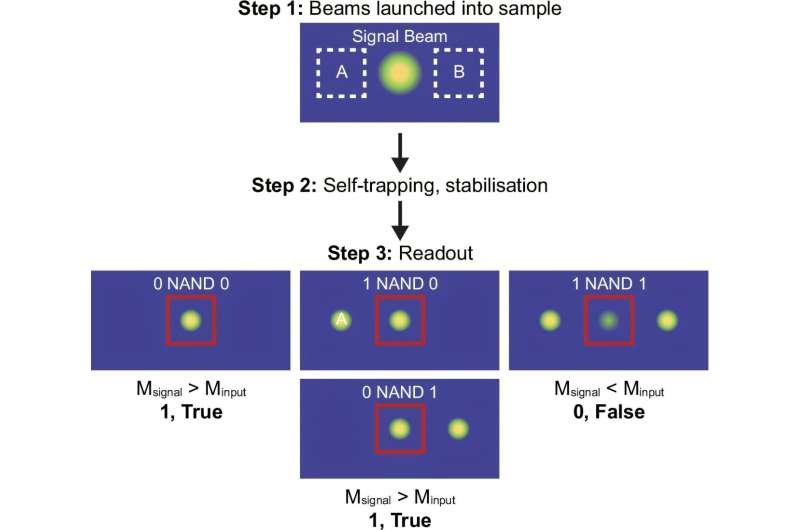Researchers from McMaster University and the University of Pittsburgh have achieved a groundbreaking milestone by developing the first functionally complete logic gate—specifically, a NAND gate—using only beams of visible light in a soft material. This discovery, detailed in a study published in Nature Communications, represents a significant advancement in the emerging field of materials that can process information independently of traditional electronic circuitry.
The first author, Fariha Mahmood, noted the importance of this project in her academic journey. “This project has been part of my scientific journey for over a decade,” she stated. Mahmood’s research began during her undergraduate studies at McMaster and has continued as she pursues postdoctoral research at the University of Cambridge. She expressed her excitement in seeing materials that not only respond to light but can also perform logic operations, describing it as akin to observing the material “think.”
Joining her in this research are co-authors Anna C. Balazs, a distinguished professor of chemical and petroleum engineering, and Victor V. Yashin, a research assistant professor at Pitt’s Swanson School of Engineering. The corresponding author, Kalaichelvi Saravanamuttu, a professor of chemistry and chemical biology at McMaster, emphasized the significance of this achievement in establishing soft, photoresponsive materials as viable platforms for autonomous systems capable of computation.
Transforming Light into Logic
The team successfully demonstrated that shining three self-trapped light beams into a specially engineered hydrogel can perform a NAND logic operation, a fundamental building block of digital computing. This achievement validates the concept of “materials that compute,” where the material itself carries out tasks traditionally performed by electronic devices.
The work builds on earlier theoretical and computational studies by Balazs and her collaborator, the late Steven P. Levitan, who passed away in 2016. Their foundational research introduced the notion that oscillating chemical gels could serve as networks capable of sensing, communicating, and computing. Mahmood recalled, “With three beams, we began to see consistent patterns of interaction that weren’t visible before,” explaining how these interactions allowed them to map a logic operation onto the soft material.
The core of this innovation lies in a merocyanine-functionalized hydrogel that contracts when illuminated. When a laser beam penetrates the gel, the contraction increases the refractive index, leading to a phenomenon in which the beam “self-traps,” becoming narrower and brighter as it travels through. This behavior becomes even more complex with the introduction of additional beams, facilitating a reliable mapping of logic operations.
Broader Implications and Future Directions
While this new system does not rival conventional semiconductor processors in speed or data density, it holds profound implications for various fields where materials must function autonomously. Potential applications include soft robotics, self-regulating medical devices, sensors in challenging environments, and adaptive materials that can reconfigure themselves.
Balazs highlighted the innovative approach of this research, stating, “We’re showing that computer logic—something we usually think of as the domain of electronics—can be carried out by a material through its own chemistry and physics.” This perspective opens new avenues for designing materials capable of complex operations without the need for traditional circuitry.
Moreover, the study sets a framework for the possibility of conducting multiple logic operations simultaneously within the same gel sample. Because the input and output signals consist solely of light beams, they can be routed, combined, or cascaded without the need for wiring.
Reflecting on the journey, Balazs noted the personal significance of this achievement, as it brings to fruition the ideas she developed with Levitan. “To see that vision realized experimentally is incredibly meaningful,” she remarked.
The implications of this research extend far beyond the laboratory, with the potential to reshape how materials are utilized in various technological and medical applications. As researchers continue to explore the capabilities of these soft, light-responsive materials, the future of autonomous computation appears brighter than ever.
For more details, refer to the original study: Fariha Mahmood et al, “A functionally complete logic gate in a soft photoresponsive hydrogel,” published in Nature Communications, March 15, 2024. DOI: 10.1038/s41467-025-64960-4.



























































